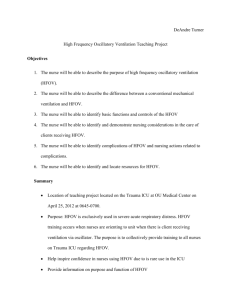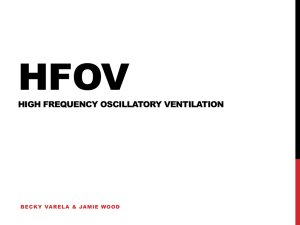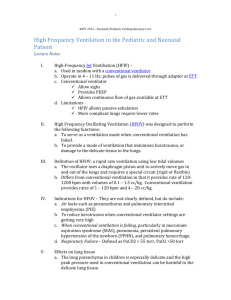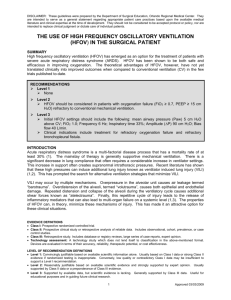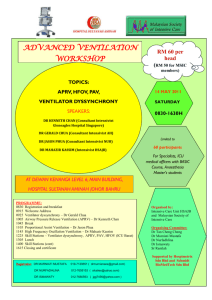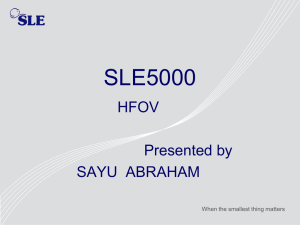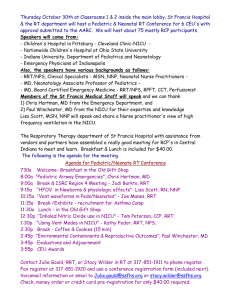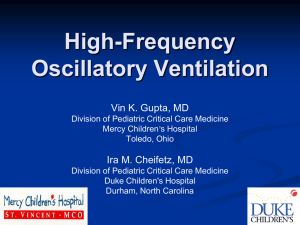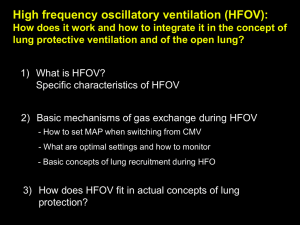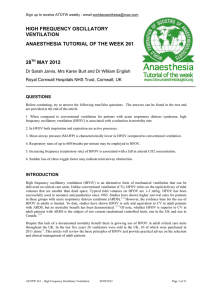Nursing Tip Sheet for Patients on HFOV (High Frequency Oscillatory
advertisement
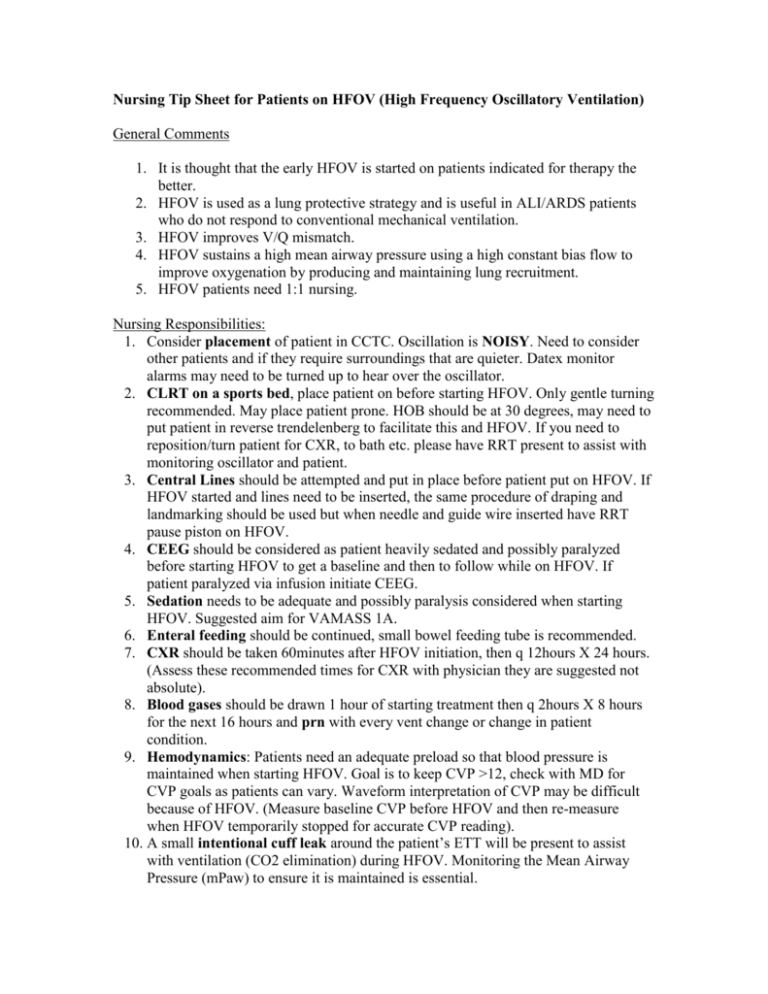
Nursing Tip Sheet for Patients on HFOV (High Frequency Oscillatory Ventilation) General Comments 1. It is thought that the early HFOV is started on patients indicated for therapy the better. 2. HFOV is used as a lung protective strategy and is useful in ALI/ARDS patients who do not respond to conventional mechanical ventilation. 3. HFOV improves V/Q mismatch. 4. HFOV sustains a high mean airway pressure using a high constant bias flow to improve oxygenation by producing and maintaining lung recruitment. 5. HFOV patients need 1:1 nursing. Nursing Responsibilities: 1. Consider placement of patient in CCTC. Oscillation is NOISY. Need to consider other patients and if they require surroundings that are quieter. Datex monitor alarms may need to be turned up to hear over the oscillator. 2. CLRT on a sports bed, place patient on before starting HFOV. Only gentle turning recommended. May place patient prone. HOB should be at 30 degrees, may need to put patient in reverse trendelenberg to facilitate this and HFOV. If you need to reposition/turn patient for CXR, to bath etc. please have RRT present to assist with monitoring oscillator and patient. 3. Central Lines should be attempted and put in place before patient put on HFOV. If HFOV started and lines need to be inserted, the same procedure of draping and landmarking should be used but when needle and guide wire inserted have RRT pause piston on HFOV. 4. CEEG should be considered as patient heavily sedated and possibly paralyzed before starting HFOV to get a baseline and then to follow while on HFOV. If patient paralyzed via infusion initiate CEEG. 5. Sedation needs to be adequate and possibly paralysis considered when starting HFOV. Suggested aim for VAMASS 1A. 6. Enteral feeding should be continued, small bowel feeding tube is recommended. 7. CXR should be taken 60minutes after HFOV initiation, then q 12hours X 24 hours. (Assess these recommended times for CXR with physician they are suggested not absolute). 8. Blood gases should be drawn 1 hour of starting treatment then q 2hours X 8 hours for the next 16 hours and prn with every vent change or change in patient condition. 9. Hemodynamics: Patients need an adequate preload so that blood pressure is maintained when starting HFOV. Goal is to keep CVP >12, check with MD for CVP goals as patients can vary. Waveform interpretation of CVP may be difficult because of HFOV. (Measure baseline CVP before HFOV and then re-measure when HFOV temporarily stopped for accurate CVP reading). 10. A small intentional cuff leak around the patient’s ETT will be present to assist with ventilation (CO2 elimination) during HFOV. Monitoring the Mean Airway Pressure (mPaw) to ensure it is maintained is essential. 11. Chest wiggle is present on HFOV from clavicular to mid- thigh bilaterally. If a change in chest wiggle occurs a RRT needs to be notified immediately. Unilateral wiggle-may indicate right main-stem intubation or pneumothorax. Decrease Bilateral wiggle-may indicate change in lung compliance, lung/airway resistance or need for suctioning. 12. Documentation; hourly chest wiggle and sound, hourly Mean airway pressure (mPaw), hourly amplitude and Hertz (frequency) hourly- nurses will chart this from the oscillator. Chest wiggle and sound will be documented on the A & I with description as well as on the flowsheet. The description of chest wiggle and sound can be difficult so on shift change, perform an assessment of chest wiggle and sound with oncoming shift or anyone covering patient. Some traditional audible alarms may not be available on the HFOV only visual by flashing lights. Notify RRT immediately if alarm activated. 13. Head movement or repositioning may cause a HFOV to alarm and stop. Be very careful when repositioning the patient’s head. 14. The circuit of the HFOV must always remain straight, not kinked or twisted because it will increase impedance. 15. Heart, lung and bowel sounds will not be able to be heard over the noise of the HFOV. Try to collaborate with the RRT and MD to listen at the same time by having the RRT turn off the piston of the HFOV. Stopping the piston stops the constant mean airway pressure from being maintained. 16. Suctioning requires the assistance of the RRT as the piston on the HFOV must be stopped and the RRT may need to perform a lung recruitment strategy post suctioning. Suctioning should be avoided the first 12-24 hours to encourage lung recruitment. 17. PPE- Use additional precautions-Please wear a face mask with shield when in the room with a patient on HFOV. (within 1 meter of patient).
